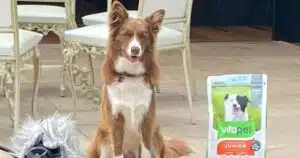

Dogs with Chronic Kidney Disease are often put on dry or canned food prescription diets by their Vets, but there is an alternative approach that can be taken for owners that want to provide their dog with the best nutrition available by choosing a complete and balanced raw food diet.
We talk to Clinical Naturopath and herbalist, and pet food nutritionist, Narelle Cooke, about her approach to kidney disease and how to ensure you are choosing the right product that will work alongside your Vet’s treatment plan.
While age is a big factor in dogs being diagnosed with Chronic Kidney Disease, it can also be found in dogs as young as one year of age, so poor breeding and genetics can play a role as well.
The other contributors include poor diet, dental disease, plus the toxins found in many common household products, from gardening to cleaning products through to synthetic air fresheners and spray, are also causing disease and illness in our pets.
Unfortunately, often by the time it is identified, there is a 75% loss of kidney function already, so treatment won’t reverse the condition, but it can slow down, so that’s why it is so important to get a annual blood test and for older dogs six monthly blood tests to help identify issues as early as possible.
I believe nutrition is no doubt the most important aspect of Chronic Kidney Disease management in our dogs.
Unfortunately, on of the main concerns that vets have with recommending a raw food diet for a condition such as kidney disease, is that it’s high in protein and can also be high in another nutrient, called phosphorus. This is often why they suggest a kidney specific prescription diet, but it’s not black and white.
For example, feeding a protein source that has a low biological value, such as what comes from plant sources of protein like corn and soy, is what you tend to find in many commercial kibbles.
This actually creates more work for the kidneys than a protein with a high biological value, such as what comes from raw meat, so I believe that needs to be considered much more than it currently is. Many of the ingredients in dry dog food can contribute to skin issues, and also cause inflammation in the body.
Ensuring safe, but adequate levels of protein in the diet is also really important to ensure a good movement of fluids through the kidneys, to maintain muscle mass and to support immune function, especially in senior dogs, so again this is where a species specific and appropriate raw food diet can help.
Firstly, there are good guidelines outlining the safe amounts of protein and phosphorus for dogs in different stages of kidney disease, so I’m always looking to work within those guidelines with my doggy clients.
Next, because diseased kidneys aren’t as efficient at excreting waste products from the body, ensuring adequate water intake is really important.
And this is where raw food can make a big difference, because it contains on average around 75% moisture, whereas a standard commercial kibble contains only about 10% moisture, which can be very dehydrating and put a further strain on the kidneys.
Then I’m looking for a high quality, highly bioavailable protein source that’s also low in phosphorus.
Fortunately, Big Dog Pet Foods do provide proteins that have very low phosphorus content, including the Goat Single Protein option.
The Turkey Option is another option and, most recently, Big Dog have released their Nourish Nutrition range which includes a Kidney Support product that contains some key herbs that support kidney function, including nettle, which acts as a natural diuretic that allows proper fluid flow through the kidneys – which is exactly what dogs with chronic kidney disease need.
Ensuring your dog has plenty of access to fresh and, ideally, purified water and monitoring for any changes in their water consumption. Learn about the importance of moisture in your dog’s diet, HERE.
Also ensuring, switching to non-toxic cleaning products, air fresheners and room sprays can help reduce the toxic chemical burden our pets are being subjected to. Use pet safe essential oils, as an alternative.
Most importantly, and starting as early as possible, stop feeding an ultra-processed dry dog food to your diet and slowly transition across to a complete and balanced raw food diet.
Read more about the impact dry dog food has on your dog’s health HERE and how to transition your dog across to a raw food diet safely HERE.





Can I use Antihistamines for dog allergies?

Receive a FREE copy of the E-Book “A Pawsome Guide For Travelling With Your Dog”


Get your paws on Lara Shannon’s best selling books ‘Eat, Play, Love (your dog) and World of Dogs.
Available in Australia, USA, UK and Canada.